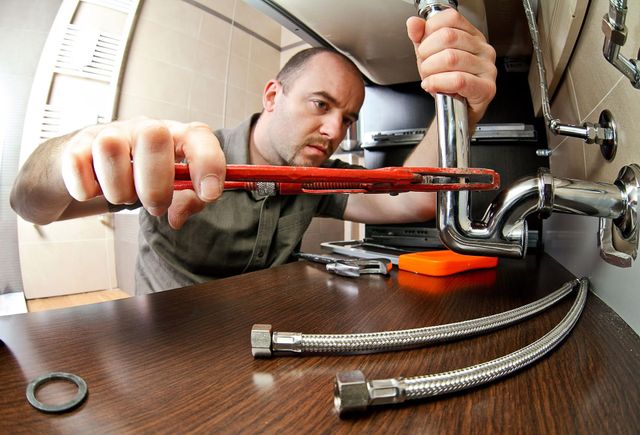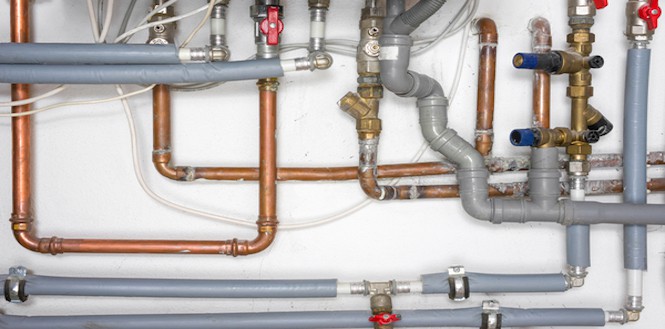The Key Components of Your Home's Plumbing System
The Key Components of Your Home's Plumbing System
Blog Article
The publisher is making a number of great annotation regarding Plumbing Installation 101: All You Need to Know in general in this great article on the next paragraphs.

Comprehending exactly how your home's pipes system functions is vital for every single home owner. From providing clean water for alcohol consumption, cooking, and showering to safely getting rid of wastewater, a well-maintained plumbing system is important for your family members's health and convenience. In this comprehensive overview, we'll check out the detailed network that comprises your home's pipes and offer ideas on maintenance, upgrades, and managing usual problems.
Intro
Your home's plumbing system is more than simply a network of pipelines; it's a complex system that guarantees you have accessibility to clean water and efficient wastewater removal. Recognizing its components and exactly how they interact can help you prevent expensive repair services and make sure every little thing runs efficiently.
Basic Components of a Pipes System
Pipes and Tubes
At the heart of your pipes system are the pipelines and tubes that lug water throughout your home. These can be made of numerous products such as copper, PVC, or PEX, each with its benefits in terms of longevity and cost-effectiveness.
Fixtures: Sinks, Toilets, Showers, etc.
Components like sinks, commodes, showers, and bathtubs are where water is used in your home. Understanding how these components connect to the plumbing system assists in detecting troubles and planning upgrades.
Valves and Shut-off Points
Shutoffs regulate the circulation of water in your plumbing system. Shut-off valves are important throughout emergency situations or when you require to make repair services, permitting you to isolate parts of the system without interfering with water circulation to the whole house.
Water Supply System
Main Water Line
The main water line connects your home to the metropolitan water supply or a private well. It's where water enters your home and is distributed to different fixtures.
Water Meter and Pressure Regulator
The water meter procedures your water usage, while a pressure regulatory authority makes certain that water flows at a safe pressure throughout your home's plumbing system, preventing damage to pipes and components.
Cold Water vs. Warm water Lines
Recognizing the distinction between cold water lines, which supply water directly from the major, and warm water lines, which carry heated water from the water heater, helps in troubleshooting and preparing for upgrades.
Water drainage System
Drain Pipes and Traps
Drain pipes lug wastewater far from sinks, showers, and bathrooms to the sewer or septic system. Catches stop sewer gases from entering your home and likewise catch debris that could trigger clogs.
Air flow Pipelines
Ventilation pipelines enable air into the water drainage system, avoiding suction that can reduce drain and trigger traps to vacant. Appropriate ventilation is vital for maintaining the honesty of your pipes system.
Value of Proper Water Drainage
Making certain appropriate drain prevents back-ups and water damages. On a regular basis cleaning drains pipes and maintaining catches can avoid pricey repair services and prolong the life of your plumbing system.
Water Furnace
Types of Hot Water Heater
Hot water heater can be tankless or conventional tank-style. Tankless heating units heat water as needed, while storage tanks store heated water for immediate usage.
Upgrading Your Plumbing System
Factors for Updating
Upgrading to water-efficient components or replacing old pipelines can enhance water top quality, reduce water costs, and enhance the worth of your home.
Modern Plumbing Technologies and Their Advantages
Explore technologies like wise leak detectors, water-saving commodes, and energy-efficient water heaters that can save cash and minimize environmental effect.
Cost Factors To Consider and ROI
Calculate the in advance costs versus lasting savings when thinking about plumbing upgrades. Numerous upgrades spend for themselves via decreased energy bills and less fixings.
How Water Heaters Attach to the Plumbing System
Comprehending how hot water heater attach to both the cold water supply and hot water circulation lines helps in detecting issues like inadequate warm water or leakages.
Maintenance Tips for Water Heaters
On a regular basis flushing your water heater to remove debris, examining the temperature settings, and checking for leakages can prolong its life-span and boost energy effectiveness.
Usual Plumbing Problems
Leakages and Their Reasons
Leakages can occur because of maturing pipelines, loosened fittings, or high water pressure. Attending to leaks immediately prevents water damage and mold and mildew development.
Clogs and Obstructions
Obstructions in drains pipes and toilets are typically brought on by purging non-flushable items or a build-up of oil and hair. Making use of drain screens and bearing in mind what drops your drains pipes can protect against obstructions.
Signs of Plumbing Issues to Watch For
Low water pressure, sluggish drains pipes, foul odors, or abnormally high water bills are indicators of potential plumbing problems that should be dealt with immediately.
Pipes Upkeep Tips
Normal Examinations and Checks
Set up yearly pipes assessments to capture concerns early. Seek signs of leaks, corrosion, or mineral build-up in taps and showerheads.
Do It Yourself Upkeep Tasks
Straightforward jobs like cleaning faucet aerators, checking for commode leakages using color tablet computers, or protecting subjected pipes in cold environments can stop major plumbing issues.
When to Call a Professional Plumber
Know when a pipes problem needs professional expertise. Trying complicated repairs without appropriate knowledge can bring about more damage and greater repair service expenses.
Tips for Decreasing Water Usage
Basic practices like fixing leaks promptly, taking much shorter showers, and running full loads of washing and dishes can save water and lower your energy expenses.
Eco-Friendly Plumbing Options
Take into consideration sustainable pipes products like bamboo for flooring, which is durable and eco-friendly, or recycled glass for counter tops.
Emergency Readiness
Steps to Take Throughout a Plumbing Emergency situation
Know where your shut-off valves lie and how to shut off the water in case of a burst pipeline or significant leak.
Value of Having Emergency Contacts Useful
Maintain get in touch with details for regional plumbing professionals or emergency solutions readily available for fast reaction during a pipes crisis.
Ecological Impact and Preservation
Water-Saving Fixtures and Home Appliances
Installing low-flow taps, showerheads, and toilets can dramatically decrease water use without sacrificing performance.
Do It Yourself Emergency Fixes (When Suitable).
Short-lived fixes like using duct tape to spot a leaking pipe or positioning a bucket under a leaking faucet can lessen damage until an expert plumber shows up.
Verdict.
Comprehending the makeup of your home's plumbing system equips you to keep it effectively, saving money and time on fixings. By adhering to normal maintenance routines and staying notified concerning modern-day plumbing innovations, you can guarantee your pipes system runs successfully for years to come.
The Anatomy of Your Home s Plumbing System
Understanding the anatomy of your home s plumbing system is essential for any homeowner. It not only helps in identifying potential issues but also facilitates effective communication with professionals when repairs or upgrades are needed. Your home s plumbing system is more than just pipes and faucets; it s a complex network that ensures the efficient and hygienic flow of water in and out of your house. In this blog, we ll dissect the crucial components of your home s plumbing system. For those in Antelope Valley, Brock Plumbing is your trusted partner for all your plumbing needs, ensuring your system functions smoothly and efficiently.
Water Supply System
Main Water Line: This is where your home s plumbing system begins. The main water line connects your home to the public water supply or a private well. Pipes and Shut-off Valves: Pipes distribute water throughout your home. Shut-off valves are crucial for controlling the flow of water and making repairs without shutting off the entire system. Drainage System
Drain Pipes: These pipes carry waste and water away from sinks, toilets, and showers. Vents: Vents allow sewer gases to escape and help maintain proper pressure in the drainage pipes, ensuring efficient flow of wastewater. Traps: Every fixture has a trap, a U-shaped pipe that holds water and prevents sewer gases from entering your home. The most common is the P-trap under sinks. Fixtures and Appliances
Fixtures and appliances are the most interacted with parts of your plumbing system. They include sinks, toilets, showers, dishwashers, and washing machines. Each fixture and appliance has its own supply and drainage connection, ensuring they receive clean water and can dispose of wastewater effectively.
Water Heating System
Your water heater is a crucial component, providing hot water to various fixtures and appliances in your home. It can be tank-based or tankless, with each type having its own set of advantages and maintenance requirements. Regular maintenance is essential to ensure efficient operation and extend the lifespan of the unit.
Sump Pump
In areas prone to flooding or with high water tables, a sump pump is an essential part of the plumbing system. It s installed in the lowest part of your basement or crawlspace and pumps out water that accumulates, preventing flooding and protecting your home from water damage.
Septic System
Homes that are not connected to a municipal sewer system have a septic system and an underground wastewater treatment structure. Understanding how to maintain your septic system is crucial to prevent backups, odors, and early system failure.
Conclusion
Your home s plumbing system is a complex and essential network, ensuring the efficient and hygienic flow of water in and out of your property. Understanding its key components helps in maintaining it properly and identifying issues before they escalate into major problems. For residents in Antelope Valley, Brock Plumbing is dedicated to providing top-notch services, ensuring that every part of your plumbing system is in perfect working order. Trust our team of professionals to handle all your plumbing needs, ensuring your home remains comfortable, safe, and well-maintained.
https://brockplumbinganddrains.com/blog/the-anatomy-of-your-homes-plumbing-system/

I am just very drawn to Understanding Your Home's Plumbing Anatomy and I really hope you appreciated the blog posting. Sharing is caring. Helping others is fun. Thanks for being here. Come back soon.
Details Report this page